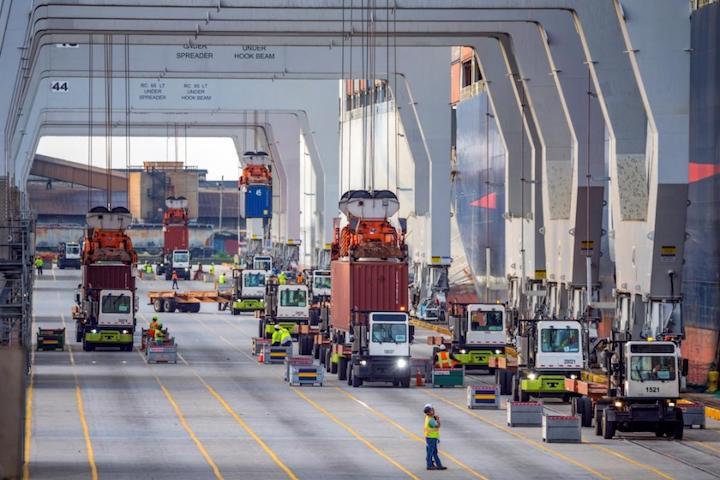As the Port of Savannah achieved its busiest September ever, moving 472,000 twenty-foot equivalent container units (up 14.5 percent), officials say Garden City Terminal has seen steady improvement in the speed of cargo moving from dock to destination.
“Our team is doing a great job, handling an immense volume of cargo every day,” said Griff Lynch, executive director of the Georgia Ports Authority. “I’d also like to extend our appreciation to our many customers, who are working in lockstep with us to move cargo more quickly and work vessels with greater efficiency.”
Total cargo for September reached 3.3 million tons, up 250,000 or 8 percent. Truck traffic remains fluid at Garden City Terminal, where single container moves over the past month averaged 38 minutes and dual import-export moves 60 minutes. The port’s truck gates are averaging 70,000 moves per week, counting both import and export cargo, while intermodal containers take less than two days to move from vessel offload to departing rail.

To help address current and future needs, Georgia Ports will soon roll out two major capacity enhancements: completion of the Mason Mega Rail Terminal and Phase I of the Peak Capacity project. With the Mason Mega Rail Terminal fully operational by the end of October, the Port of Savannah’s annual rail capacity will be 2 million TEUs per year.
The Port of Savannah is averaging less than two days from vessel offload to departing train, and rail providers Norfolk Southern and CSX have untapped capacity to destinations such as Atlanta, Memphis, Charlotte and Birmingham. GPA is encouraging port customers to transfer containers from truck to rail in order to expedite cargo and reduce carbon emissions. The authority is also making more room for on-terminal container storage.
GPA’s other project soon to be commissioned is Peak Capacity, Phase I. This project, more than 80 percent complete, will come online in December with three new rubber-tired gantry crane rows providing an additional 300,000 TEUs of annual capacity. Phase II will add a fourth RTG row and additional empty container space by the spring of 2022. The entire project will add 800,000 TEUs of annual capacity.
GPA is currently investing $700 million in projects to expand berth capacity and to add 1 million TEUs of yard capacity. By next spring, additional projects will bring the total capacity increase to 2 million TEUs.
Other infrastructure projects in the works include:
- Garden City West Phase I, a new 25-acre chassis yard. Notice to proceed on construction goes out Monday. The chassis yard is set to open in March 2022.
- Garden City West Phase II, a 92-acre container yard, goes before the GPA Board for consideration in March. Will add 750,000 TEUs of annual container space in 2023.
- Berth 1 Expansion: 17% complete. The project, slated to come online in 2023, will allow Savannah to simultaneously serve four 16,000-TEU vessels, and three additional ships.
- Ship-to-Shore Crane order: First four, 15% complete; second four, 5% complete. Eight new ship-to-shore cranes will arrive in 2023, bringing Garden City Terminal’s total fleet to 38.
- Savannah Harbor Expansion Project: 93% complete. With a high-tide depth of 54 feet, the deeper harbor will allow vessels in the 16,000+ TEU range to take on heavier loads with fewer tidal restrictions. With another five feet of channel depth, departing vessels will be able to take on 1,000 additional export containers, which will speed American-made goods to market.









